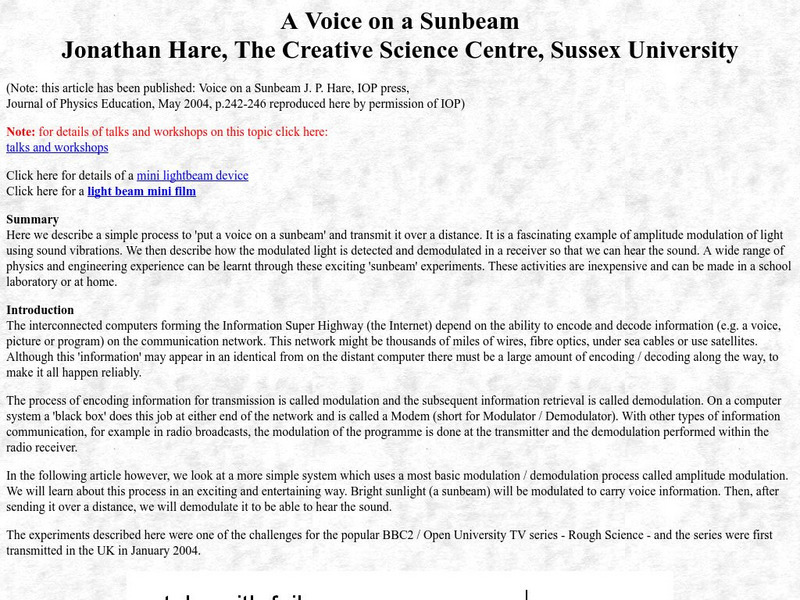Hi, what do you want to do?
Other
Physics and Psychophysics of Music
This site is filled with information pertaining to the physics of sound and music.
Science Buddies
Science Buddies: Extreme Sounds: Lessons in a Noisy World
Just how loud does a sound have to be for us to hear it? And how loud is too loud for our ears? Learn to measure levels of sound in this project, and discover the amazing auditory range your ears can detect in the noisy world around you.
Science Buddies
Science Buddies: Measuring Vibrational Frequency With Light
Strike a key on the piano, and you hear the string vibrating. Just about any object vibrates when it's knocked, but how much and how fast? This project helps you find out. You'll build a simple light-sensing circuit for measuring the...
Curated OER
Kids Health: Let's Hear It for the Ear!
Use this site to learn about the body part that is responsible for collecting sounds, processing them and sending them to your brain. See all the inner workings of the ear through great diagrams. Available in Spanish.
Scholastic
Scholastic Instructor: Science of Sound
This resource is for teachers who are looking for information, activities, experiments, and more pertaining to the science of sound.
Creative Science Centre
Creative Science Centre: A Voice on a Sunbeam
Here is described a simple process to 'put a voice on a sunbeam' and transmit it over a distance. It is a fascinating example of amplitude modulation of light using sound vibrations. It then describes how the modulated light is detected...
Science Buddies
Science Buddies: Sound Bites: Tasting the Texture of Classical Music
Did you know that your sense of hearing can determine texture? This Science Buddies science fair project has you experiment with four major eras in western music to determine the texture of the music. The Science Buddies project ideas...
E-learning for Kids
E Learning for Kids: Science: Seychelles: How Do We Hear?
This lesson teaches students about how sound vibrations are transmitted through solids, liquids, and gases, and about how materials may absorb sound.
TED Talks
Ted: Ted Ed: The Science of Hearing
To understand how hearing works, Douglas L. Oliver follows a sound on its journey into the ear. [5:17]
Other
Siemens Science Day: Life Science: Hear Ye! Hear Ye! [Pdf]
Through this hands-on science activity, students make a model of the human ear as well as explore the parts of the ear and their roles in transferring sound.
Khan Academy
Khan Academy: The Effects of Ear Canal Acoustics on Hearing Ability
This is a five-question quiz related to the passage "The Effects of Ear Canal Acoustics on Hearing Ability."
CK-12 Foundation
Ck 12: Physical Science: Hearing and the Ear
[Free Registration/Login may be required to access all resource tools.] Explains how we hear sound, how the ear works, and the different structures of the ear.
CK-12 Foundation
Ck 12: Life Science: Hearing and Balance
[Free Registration/Login may be required to access all resource tools.] What do listening to music and riding a bike have in common? It might surprise you to learn that both activities depend on your ears. The ears do more than just...
University of Washington
Hearing: Activities, Experiments, Models and More
Come and learn more about one of the five senses? Hearing is an integral part of our everyday life. To learn more use the activities, experiments, models and more wrapped into this hearing website.
PBS
Pbs Teachers: Scientific American: The Art of Science: Ben Franklin's Harmonica
Investigate the science behind the glass harmonica, and try Ben Franklin's version. Explore the world of sound with hearing and other senses, and find out how different length straws influence sound by modifying frequency.
National Science Foundation
National Science Foundation: Language and Linguistics
The language we use everyday reveals a great deal about who we are and where we come from. However, did you know that language is linked to psychology, biology, and other sciences? Explore the "science" of language: how the brain...
Songs for Teaching
Sciences Songs All Day Long: Nocturnal Animals
By listening to this song your students will learn all of the animals that are awake during the night. They will equate the sounds they hear at night with the animals and their sounds in the song.
PBS
Pbs Learning Media: Atlanta Symphony Orchestra: Live Exploration
Take a special trip to the Atlanta Symphony Orchestra with GPB Education! This interactive virtual exploration offers students a behind-the-scenes experience as they learn about the science of sound and the preparation it takes to put on...
PBS
Pbs Teachers: Scientific American: Growing Up Different: In Tune
Explore the science of sound and the human ear, and explain how this applies to the operation of cochlear implants for the deaf. Observe how structures can be "tuned" to respond to different frequencies.
Ducksters
Ducksters: Biology for Kids: Hearing and the Ear
Kids learn about the science of hearing and the ear. A sense that detects sound.
Ducksters
Ducksters: Physics for Kids: Sound Pitch and Acoustics
Kids learn more about the science and physics of sound. Pitch, acoustics, and the doppler effect. How the frequency of the sound wave affects the pitch we hear.
Khan Academy
Khan Academy: Functions of the Basilar Membrane
Read the passage "Functions of the Basilar Membrane" and complete the five-question quiz related to hearing.
Khan Academy
Khan Academy: Differential Effectiveness of Cochlear Implants
Read the passage "Differential Effectiveness of Cochlear Implants" and complete the related five-question quiz.














![Siemens Science Day: Life Science: Hear Ye! Hear Ye! [Pdf] Lesson Plan Siemens Science Day: Life Science: Hear Ye! Hear Ye! [Pdf] Lesson Plan](https://static.lp.lexp.cloud/images/attachment_defaults/resource/large/FPO-knovation.png)











